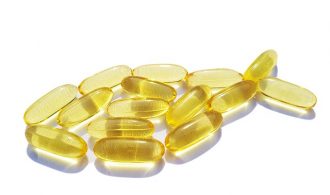popular brands have this for capsule ingredients:
Gelatin, Glycerine, Water, Methacrylic, Acid Copolymer, Polysorbate 80, Glyceryl Monostearate, Triethyl Citrate, Tocopherols, and last but not least: Propylene Glyclol
Are you kidding me? Scour the internet for case studies and material safety data sheets and no way are these chemicals going into my dog. He has enough problems!
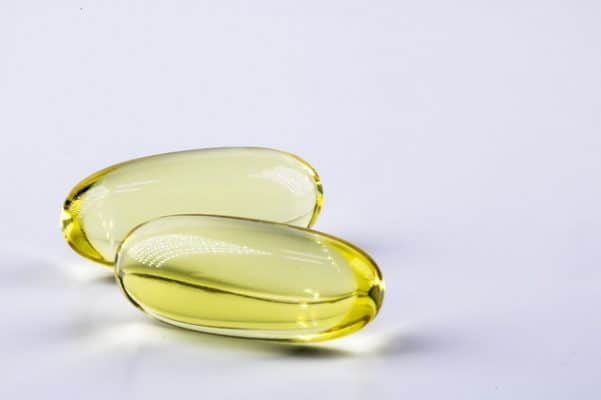
Bottom line when it comes to dog’s having an Allergic Reaction to Fish Oil, you have to consider all ingredients swirling around in that fish oil bottle or fish oil pill, not just the oil. .
Allergic Reaction to Fish Oil Supplements (oil, other additives, chemicals)
This is where spending time conducting product research of the fish oil you are considering giving your dog will have its largest benefits. The fish oil COULD be to blame but so could any other ingredient. The allergic reaction symptoms are:
- Vomiting
- Diarrhea
- Nausea
- Scratching
- Drooling
- Runny Nose
- Death
Best Practice for Avoiding Allergic Reaction – Unless you are absolutely certain your dog does not have a fish allergy, start small with fish oil and make sure the fish oil you select has zero chemicals or other ingredients added. Use the lowest dose recommended by your vet and see how they respond.
Overdosing a Dog’s Fish Oil
Now we are going to talk about overdosing a dog with fish oil or omega-3. Overdosing happens when you give your dog a higher dose than what’s recommended and for over a period of some time. Let’s revisit recommended dosing as set by the National Research Council.
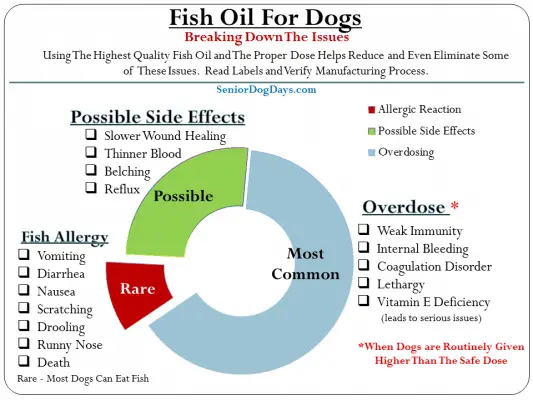
According to the National Research Council, their data suggests that a safe dose for dogs would be between 20-55mg combined EPA and DHA per pound of body weight.
Remember when I said all 3 of my vets gave different recommended doses to give my dog. I stick on the low end because that’s where I’m most comfortable and I see results. My dog fluctuates in weight between 85 and 91 pounds and he receives 1500mg.
Here are other symptoms of Fish Oil overdosing
- Weak Immunity
- Internal Bleeding
- Coagulation Disorder
- Lethargy
- Diarrhea
- Vitamin E Deficiency – (leads to serious issues)
Now let’s talk about a few of these symptoms to find out what could be causing them.
Weak Immunity
An overabundance of free radicals in the body leads to weakened immunity. So how might omega-3 supplements lead to an increase in free radicals? We’re going to keep this very generic but I encourage you to research Oxidation and Peroxidation. Here it is in a nutshell:
Oxidation vs. Peroxidation
For our purposes, oxidation is a result of omega-3 enriched food or supplements being exposed to oxygen. And Peroxidation is the EFFECT of that exposure. So omega-3’s that come into contact with oxygen will begin the process of peroxidation.
We touched on this briefly earlier: one of the reasons why commercially available foods containing Omega-3’s might not have the omegas when you actually go to feed your dog and go rancid quickly is because exposure to oxygen destroys omega-3 fatty acids.
When Peroxidation Occurs
Peroxidation can occur in the food, kibble or the supplement itself before it is fed to your dog. When omega-3 enriched food goes rancid and begins the process of peroxidation, you may inadvertently be feeding your dog free radicals.
And peroxidation can also occur once omega-3 fatty acids enter the body and begin to distribute to blood cells. This is because blood cells contain oxygen and oxygen destroys fatty acids…even inside the body.
Not to get off track but this is an important illustration of peroxidation of omega-3 inside the body. Studies show a link between fatty acid peroxidation and Alzheimer’s disease.
Research showed that in postmortem tissue studies, brain tissue of humans with Alzheimer’s had elevated levels of lipid peroxidation (i.e. those byproducts created when the omega-3 fatty acid oxidizes).
But the good news is; there an easy solution to preventing peroxidation of fatty acids both inside the body and outside of the body.
How to Prevent Peroxidation of Fatty Acids
Fatty acids such as the EPA and DHA in fish oil are highly susceptible to lipid peroxidation WHEN, (that’s a big WHEN) WHEN antioxidants are not concurrently provided to protect them the peroxidation process.
When we feed our dogs fish oil, omega‐3 fatty acid supplements, EPA and DHA begin to accumulate in cell membranes and in those cell membranes; they come into contact with oxygen.
If antioxidants are not provided at adequate concentrations, the peroxidation process begins and free radicals can form as a result.
There are two ways to provide antioxidant protection to these omega-3 fatty acids and they are
- Adding an antioxidant to the food or supplement itself
- Supplementing your dog’s diet with the antioxidant.
Enter: Vitamin E
Vitamin E Antioxidant
Vitamin E is an antioxidant that protects these omega-3 fatty acids from deteriorating and going rancid (peroxidation process). This is why you are very likely to see fish oils and fish oil capsules with added Vitamin E (labeled Tocopherols). Problem solved? Maybe, but the manufacturing process and storage handling can come into play. Vitamin E deteriorates with air exposure, light exposure or high heat.
So, the Vitamin E sprayed onto kibble or added to fish-oil in an effort to protect the omega-3 from going rancid could be completely ineffective if the kibble or oil is exposed to light, oxygen or high heat: all likely scenarios.
Best Practices for Not Causing a Weakened Immune System – Give your dog high quality omega-3 supplements that are manufactured by companies who actually test their product for peroxide levels before putting it to market. They go the extra mile of encapsulating it or bottling it in light proof capsules or bottles, especially if they are adding Vitamin E (and bottles should be airtight) so peroxidation does not reach unsafe levels.
What are the safe levels of peroxidation: Fresh fish has 0 and as it ages, peroxide level raises. The maximum safe level of lipid peroxide is 5.0. Proud companies report their omega-3 peroxide values to the consumer and companies who may not be so proud don’t list the peroxide value.
Flavored capsules or oil may be masking the taste of putrid fish which could be a bad sign. Fresh fish oil with limited peroxidation (much like fresh fish) does not smell like rotten fish. You can taste for rancidity when you buy a fish oil supplement that doesn’t have added flavors.
We’re going to move on with signs of overdosing and that’s when high levels of omega-3’s in the body cause a Vitamin E deficiency.
Very Serious Vitamin E Deficiency
So if you remember back near the beginning of this article I mentioned that I supplement my dog’s omega-3 supplement with Vitamin E (product link) And this is because too much omega-3 can (not will, but can) deplete vitamin E and overdosing the omega-3 makes this far more likely.
Vitamin E is an essential vitamin for dogs, which means it must be part of their diet in order for your dog to maintain optimal health. Why would omega-3 deplete Vitamin E levels? Vitamin E is an antioxidant and is essential in protecting omega-3 lipids such as DHA from depleting or becoming damaged; as we just discussed when covering oxidation and peroxidation.
Omega-3 Fatty Acids Summons Vitamin E
So when you give your dog the omega-3 supplement, Vitamin E is pulled out of your dog’s stores and used to protect these new lipids, which is great. Your dog’s stored up Vitamin E is doing its job by joining up with the fatty acids so they can protect them from peroxidation as they travel through oxygen infused blood cells.
But, as you keep supplementing omega-3, especially if you’re using a higher than recommended dose (overdosing) your dog runs out of Vitamin E and becomes depleted. And when your dog has no more Vitamin E to protect the fatty acids as they travel solo through his oxygen filled blood cells , peroxidation occurs and free radicals take over.
Signs of Vitamin E Deficiency
Signs that your dog is deficient in Vitamin E include muscle weakness, trouble getting up, compromised immunity and decreased fertility. Some people mention that their dog suddenly looked like they aged overnight. Severe cases lead to lameness and a condition where the large intestine hemorrhages.
But why can’t I just use the omega-3 with vitamin E added? Doesn’t that solve the Vitamin E deficiency problem? No, if it even remains effective, that Vitamin E is just enough to help postpone that particular dose of fish oil from peroxidation. It’s not going to be used in your dog’s body to help protect fatty acids already located in blood cells.
Best Practices for Avoiding Vitamin E Deficiency – I supplement my 90 lb. dog a very low dose of Vitamin E. Once a week (sometimes more) he gets a 100 IU pill, (yes, that’s one hundred International Units, just once a week). I cannot find it at our local drugstore, but it is found here: online (Vitamin E 100IU).
The kind of Vitamin E I use is labeled as d-alpha tocopherol. This is naturally occurring vs. synthetically engineered. Synthetic is labeled with a dl-alpha prefix I don’t like it for my dog. This is exactly what it looks like and here is a picture of the pill as well:
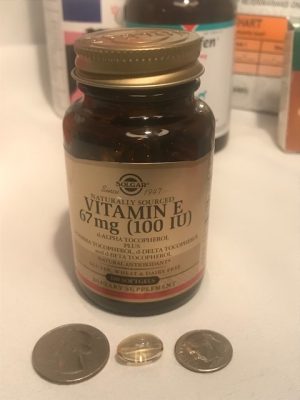
I also incorporate raw almonds for snacking and I coat some of his homemade treats in sunflower seeds. Both of these are good, natural resources for Vitamin E.
Talk to your veterinarian before adding Vitamin E to your Omega-3 supplement routine. Get their opinions on proper dosing. I supplement because my dog is so large and I can’t really give him a whole cup of almonds every day. However, if you have a small or toy breed, it’s possible your dog can get enough Vitamin E through natural foods and a supplement could be too much. That’s why a veterinarian, preferably one who specialized in nutrition, is a great asset.
Let’s cover the next symptom of overdosing.
Bleeding and Blood Disorders
If your dog is already taking a medication known for thinning the blood, then taking omega-3 supplements can certainly make thinning blood and coagulation problems even worse. If your dog is taking a medication that is specifically intended to help with coagulation because your dog already has a bleeding disorder then you should not be adding any supplements into her diet without Dr.’s orders.
I have read a few stories where well intentioned dog owners neglected to tell their veterinarian that their dog was on fish oil supplements and their dogs went in for a surgery. Always tell your veterinarian that you are giving your dog omega-3 supplements (or any supplement).
Best Practice for Counteracting Thin Blood
We all know Vitamin K helps blood to clot normally. And if you’re supplementing omega-3’s you could try foods high in Vitamin K as a counter balanced approach. My dog eats a raw diet and Kale, which is loaded with Vitamin K is added to his raw meat mixture.
My dog will not eat Kale on its own so I have to put it in his raw food and he scarfs it down no problem. In addition to Kale, my dog loves roasted brussel sprouts and broccoli and I roast it weekly for treats for added vitamin K.
Diarrhea
Many studies reveal that high doses of omega-3 fatty acids can cause diarrhea in dogs. When too many fatty acids are undigested they move through the intestines and make a cozy home for bacteria. As bacteria begin to accumulate on their newfound fatty beds, they multiply and cause horrible diarrhea.
If your dog has diarrhea after giving fish oil, it’s probably not a coincidence, stop the supplement and regroup with your veterinarian. It’s possible a lower dose might be just as effective without causing the gastro disturbances.
Fish Oil for Dog Likely Side Effects
So we’ve talked about allergic reactions and overdosing but what about just your normal average side effects of giving your dog fish oil. While many side effects are simply waterered down overdosing symptoms, there are a couple worth mentioning.
Like most supplements and dietary issues with senior dog’s the conclusions will be very individual. But let’s try to address the most common side effects reported when giving a dog fish oil.
Burping, Gagging, or Throwing Up the Pill
Just because a dog is big in size doesn’t mean she’ll have an easy time swallowing a fish oil capsule. If you’ve ever taken Fish oil capsules yourself, you know the larger style is not so easy to swallow. Even after you do swallow the mammoth pill, it sure seems to take its time reaching the final destination, and sometimes is feels just plain stuck.
If you haven’t ever tried to swallow a fish capsule; please try it. Attempt it a couple of times so you know the feeling before giving it to your dog.
The last thing you want to do when trying to help your dog is create pain or discomfort and giving a capsule could absolutely cause pain or discomfort. For an in depth read on giving your dog Human Fish Oil Capsules, here is an article: Human Fish Capsules for Dogs.
Upset Stomach
Again, this could be the fish oil but more than likely it’s something else added to the fish oil. Our dogs are very sensitive to chemicals and additives so pay special attention to every single ingredient of the product you are feeding, not just the oil.
Fish Oil May Cause Thin Blood
We talked about his at length under overdosing and thinner blood could be a side effect even at a lower dose. Although I haven’t noticed this to be this case with my dog, I still give him extra treats high in Vitamin K . He gets Kale, brussel sprouts and broccoli on a regular basis.
Your Pet’s Current Health
Fish oil supplementation is not appropriate for all dogs. If your pet has a sensitive gastrointestinal system or any medical condition that could predispose him to excessive bleeding, or he participates in activities such as hunting or lots of running, where bleeding could occur, please discuss use of fish oil supplements with your veterinarian.
Before Beginning a Fish Oil or Omega-3 Regimen for Dogs
- Call or visit your veterinarian and tell them your plan. Have your list of medications ready and ask them to think about any unforeseen complications.
- Get a second opinion. Over the years, I’ve quite accidentally acquired 3 veterinarians. One is holistic, one is via a walk-in clinic and the other I would consider my dog’s regular vet. Veterinarians are not on retainer. You can establish your dog at more than one place, especially when they provide special services. Actually, my dog has an eye doctor too, so that’s 4 Dr.s that I get to “bend ears” so to speak.
- There is no harm is starting slow. If you’re worried about an adverse reaction why not try a half dose and work your way up to her recommended amount.
- Keep a log or diary of exactly what you’re giving your dog and how she is responding. Making sure to include not so obvious things such as “is she getting up normally?” and “is she sleeping more?” Diarrhea and vomiting will be obvious but the other signs are important to record.
- Avoid Omega-3 from mercury laden sources such as tuna.
- When you do decide that omega-3 supplement is for your and your dog, invest in the high quality products without additives.
The Omega-3 Oil I Use and Like
So, I’ve tried several varieties of omega-3 including fish oil, cod liver oil and my number one choice is Krill Oil. I should note that I always try a product first before I give it to my dog. I like to know how it tastes (freshness) and I like to know how it goes down and being that I take omega-3 supplements too for my own inflammation, it only makes sense that I try it on myself first.
And I don’t use just any Krill Oil, I use Captain’s Krill – I use this krill oil sold on amazon for me and my dog because my extensive research in the Krill harvesting and oil extruding process led me to them. Here is a picture of my bottle and you can see the size of the pill is far smaller because there aren’t added ingredients and it’s DARK to protect it from oxidation.
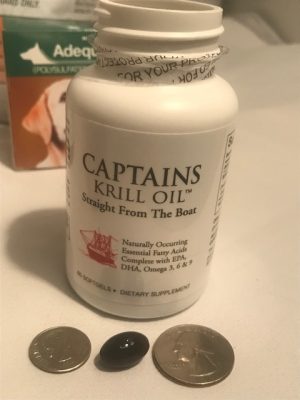
Captains Krill is a true small batch artisan of Krill oil and they don’t soak their krill in chemicals like many manufactures do. The only thing in their krill oil is the result of them pressing, fresh caught krill in American waters.
They test their product for everything, including peroxide levels and post results to the public. Love it! It is a little more expensive than some products and a lot more expensive that others, but I think it would have to be when the product is not cut with cheap additives and flavors.
In Conclusion
Unfortunately, all dietary supplements have the potential for adverse effects and you are left to weigh the benefits. But in order to weigh the benefits, it helps to educate yourself on where the risks are highest and how and when they become risks to begin with.
I know this article was really long so if you’ve gotten this far, thanks for sticking with it. I do hope that it has helped expose where, why, how and when risks appear as you give your dog omega-3 supplements and what you can do to combat the problems and only reap the benefits.
Thank you to all the dog owners who continue to share success stories and especially those who share their frightening complications of supplementing a dog with omega-3’s. I hope omega-3 supplements for dogs can turn into a success story for all. If you want to read more about Captain’s Krill, here is another article: Krill Oil for Dogs.
Thanks for stopping by!

